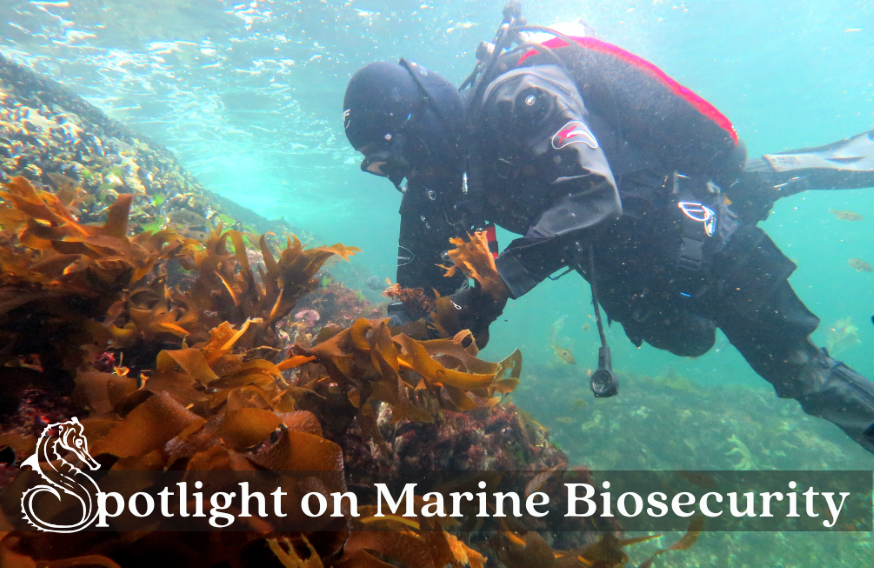
In this feature, we’re focusing on marine biosecurity; sharing insight into an invasive seaweed project and link to resources useful for learning and teaching.
The story and video below are about a team of Ocean Champions who are looking after the marine environment of Fiordland. Scroll further down and you'll find links to connect you to ways you can continue learning about marine pests, or teach others about them.
Featured photo of diver picking seaweed above by Pauline Dusseau/Environment Southland
Biosecurity has Relevance Underwater
Understanding the impact of introduced and non-indigenous species on the New Zealand ecosystem is an interesting area of research. We still have so much to learn about the organisms that are native to our marine environment that it’s a challenge to discern the cause of changes to our underwater landscape. Untangling the effects of various stressors, including those which are connected to new arrivals that take up residence in our territorial seas, presents a new challenge. Introduced species can change local community structure and ecosystem functions so it's important to be aware of these marine invaders. Below you can learn about some work in Fiordland and discover what actions to take to reduce the risk of these hitchhiker's taking stronghold in our blue backyard.
Ocean Champions of Fiordland
The Fiordland Undaria Control Programme (Undaria Project) aims to control invasive Undaria pinnatifida seaweed in Fiordland’s Te Puaitaha / Breaksea Sound and eliminate it from Taiari / Chalky Inlet. Undaria, also known as Wakame, is a kelp species native to the northwest Pacific Ocean. The Undaria Project began in 2021, through Jobs for Nature, which provided funding for projects benefiting the environment and people across Aotearoa New Zealand. While ecologically important in its native range, Undaria is invasive in New Zealand, where it can outcompete native seaweeds and potentially alter the abundance of marine animals in its surrounding waters.
Efforts to control Undaria involved extensive surveying and removal of the seaweed which was brought to our attention through a video entry submitted to us by John Carter, part of the Undaria Project Team, for the Ocean Champion Challenge 2023. The team had to initially determine the location, spatial extent and density of the seaweed in Te Puaitaha / Breaksea Sound. Focus then shifted to removing the Undaria by underwater cutting and bagging of the seaweed, so having a workforce of trained scientific divers was essential. The Undaria Project facilitators organised comprehensive scientific diver training for locals and provided all dive gear and necessary equipment for Undaria removal. Through this training, many community members have become skilled scientific divers, allowing the community to respond if the seaweed spreads again or if funding for the project continues.
Together with other project participants, The Undaria Project facilitators have removed more than 40 tonnes of Undaria from the Fiordland Marine Area and are learning heaps about how it interacts with the rest of the marine ecosystem. We would like to acknowledge the work of Kathryn McLachlan, Andrea Faris, and Pauline Dussseau, facilitators of The Undaria Project in the Fiordland Marine Area who were key players of a team which worked year-round to remove Undaria and keep the project going. Since the project’s creation, Kathryn, Andrea and Pauline are part of the Marine Biosecurity team at Environment Southland.
This Ocean Champion Challenge entry was submitted to us by John Carter who nominated four of the ladies behind the facilitation of the project.
"I can’t emphasise enough how these three characters stopped this project from falling flat and gave it wings against the odds!" - John Carter
As modest recognition for their efforts to protect the marine environment, the Undaria Project team members received ocean-themed beeswax wraps donated by Ocean Champion Challenge sponsors Honeywrap- reuseable food wraps.
For more information on the Fiordland marine biosecurity programme for invasive seaweed visit the project's page on the MPI website: mpi.govt.nz
How to Identify A Marine Pest Webinar
In March, Seaweek hosted a webinar with Aless Smith, Biosecurity Specialist at Northland Regional Council, who did a presentation on marine pest identification. You can check out the recording of How to Identify A Marine Pest via our Youtube channel.
“Marine biosecurity, like biosecurity on land, is all about protecting our coastlines from pests. On land we take action to stop pests like rats, stoats and weeds. We need to do exactly the same underwater,” says Aless Smith, Biosecurity Specialist at Northland Regional Council.
Marine Biosecurity Education Module
Working in the education sector? Check out this free marine biosecurity module designed for teachers to use with students from year 5 to 8, to help ensure the next generation understand how and why marine biosecurity is so important.
The three-part classroom module, includes activities to help teachers and learners understand what marine biosecurity is, how to identify marine pests and how to stop them spreading. Through the modules, students learn about marine pests and the impacts they can have on the marine environment and be inspired to take action to monitor and report marine pest sightings. The module includes opportunities for incorporating the process of gathering and interpreting data, using evidence, critiquing evidence, interpreting representations and engaging with science. You can download the Marine Biosecurity Education Modules now at www.marinepests.nz/schools